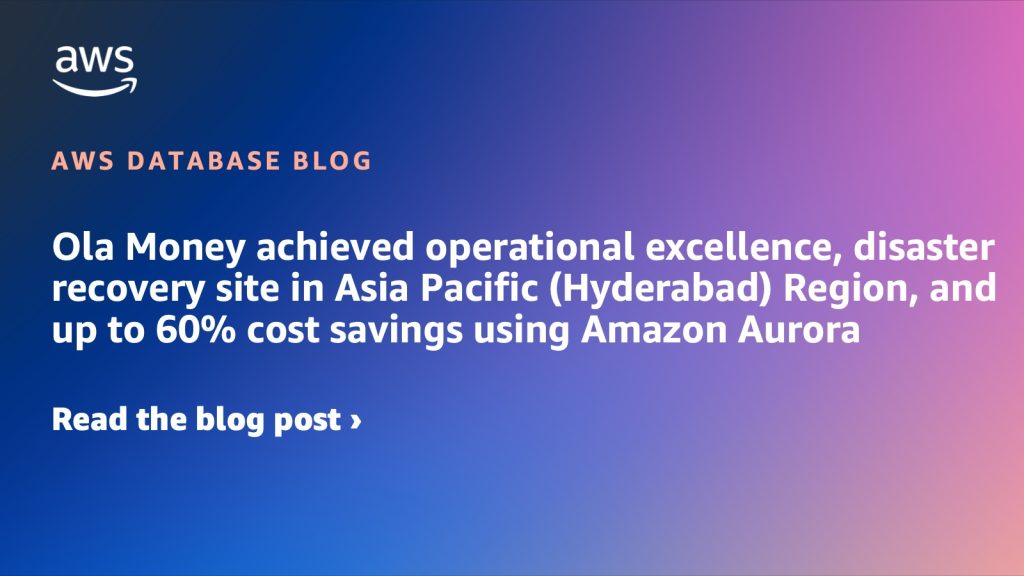AWS Database Blog
Run an Ethereum staking service on Amazon EKS
In September 2022, Ethereum transitioned to a Proof of Stake (PoS) consensus model. This change allows anyone with a minimum of 32 ether to stake their holdings and operate a validator node, thereby participating in network validation and earning staking rewards. In this post, we explore the technical challenges and requirements of operating an institutional-grade Ethereum staking service. Additionally, we outline a solution for deploying an Ethereum staking service on AWS.
Ola Money achieved operational excellence, disaster recovery site in Asia Pacific (Hyderabad) Region, and up to 60% cost savings using Amazon Aurora
Ola Money is a financial service provided by Ola Financial Services (OFS), which is part of the Ola group of companies. In this post, we share the modernization journey of Ola Money’s MySQL workloads using Amazon Aurora, a relational database management system built for the cloud with MySQL and PostgreSQL compatibility that gives the performance and availability of commercial-grade databases at one-tenth the cost.
New Amazon Neptune engine version delivers up to 9 times faster and 10 times higher throughput for openCypher query performance
Starting with the Amazon Neptune engine version 1.3.2.X, openCypher query performance is up to 9 times faster and provides up to 10 times higher throughput than previous engine releases. You can create a new cluster or upgrade to this release for faster query performance, more open source features, and additional benefits.
Export Amazon RDS for MySQL and MariaDB databases to Amazon S3 using a custom API
As customers are migrating to the AWS Cloud to take advantage of managed database services such as Amazon RDS for MySQL, Amazon RDS for MariaDB, and Amazon Aurora MySQL-Compatible Edition, they also look to automate these administrative tasks. This post shows how a DBA or other user with access to a custom API can make MySQL and MariaDB backup requests. It uses Infrastructure as Code (IaC) with the AWS CDK to simplify the deployment.
Key considerations for successful database management during a merger and acquisition
Databases form a key part of any enterprise and managing databases during an M&A requires careful planning and implementation to ensure a smooth transition and to maintain data integrity. In this post, we highlight some of the key considerations for successful database management during a merger or acquisition spanning from data assessment to integration strategies.
Enhance database performance with Amazon RDS dedicated log volumes
For those seeking to achieve consistent database transaction performance, Amazon RDS has introduced a new feature: dedicated log volume (DLV). This feature is an additional storage volume specifically for database transaction logs. In this post, we examine common DLV performance benefits, use cases, monitoring capabilities, and the cost of deployment.
Achieve near real-time analytics with Amazon DynamoDB and zero-ETL for Amazon OpenSearch Service
In this post, we explore how to transition from using Rockset to OpenSearch Service for your DynamoDB use-case effectively. To illustrate this integration, we consider a real-world example of a gaming company that tracks user interactions, such as in-game purchases and player scores, using DynamoDB. This data needs to be analyzed in real time to provide insights into user behavior, detect anomalies, and personalize the gaming experience.
Introducing Curated Solutions for Databases on AWS
Solutions on AWS help you simplify cloud adoption and accelerate time-to-value by delivering proven, ready-to-deploy architectures tailored for industry, cross-industry, and technology use cases. We have recently added a number of Guidance topics to Solutions for Databases. In this post, we provide a quick reference to the newest Guidance and how it can be used to address your business needs.
Use Oracle Real Application Clusters as a source for AWS DMS
In this post, we explore the steps to configure Oracle RAC as a source for AWS DMS.
Configure password policy for Amazon RDS for SQL Server
Amazon RDS for SQL Server now supports configuring password policies for logins using SQL Server Authentication. In this post, we guide you through the process of enabling the password policy for Amazon RDS for SQL Server and creating a SQL Server login that adheres to the policy.









